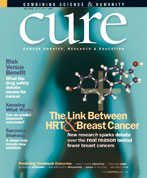Publication
Article
CURE
Removing the Guesswork
Author(s):
A number of diagnostic, prognostic, or predictive tests can help determine the optimal course of treatment by using predictive markers from the patient’s or tumor’s genetic information.
Predictive markers are quickly becoming integrated into personalized cancer therapy. Although not all novel biomarkers lead to validated diagnostic, prognostic, or predictive tests, a number of predictive markers are proven to help determine the optimal course of therapy.
Among women with advanced estrogen receptor-positive breast cancer, not all of them respond to tamoxifen, and among those tumors that do respond, some eventually become resistant to tamoxifen. Studies show tamoxifen doesn’t work as well in postmenopausal patients who carry a variant of CYP2D6, a gene that affects how tamoxifen is broken down into active byproducts, including endoxifen. An estimated 7 to 10 percent of women with breast cancer have this variant. A study published in the Journal of Clinical Oncology in 2005 found women who inherit the variant of CYP2D6 may be at a higher risk for recurrence even with the use of tamoxifen.
When epidermal growth factor binds to its receptor, it triggers a signaling process that encourages cancer growth. Targeted drugs on the market that inhibit EGFR include Tarceva (erlotinib) for non-small cell lung and pancreatic cancers, and Erbitux (cetuximab) for head and neck and colorectal cancers. Research has shown tumors containing the EGFR mutation, and possibly tumors that overexpress the EGFR gene, may be more sensitive to EGFR inhibitors like Erbitux and Tarceva.
Estrogen receptor-positive cancers, which make up about 70 percent of all breast cancers, are more likely to respond to anti-estrogen therapies, which include tamoxifen and the aromatase inhibitors Arimidex (anastrozole), Aromasin (exemestane), and Femara (letrozole). Estrogen and its receptor have also been implicated in the development or progression of ovarian, colon, prostate, and endometrial cancers, but more research is needed to validate estrogen receptor as a biomarker for these cancers.
Women with HER2-positive breast cancer make up about 25 percent of all breast cancer patients, and these tumors tend to be more aggressive than HER2-negative breast cancer. Herceptin (trastuzumab) and Tykerb (lapatinib) target HER2, a protein present in normal breast cells that is overly abundant in some malignant cells. Herceptin targets only HER2, while Tykerb inhibits both HER2 and HER1 (EGFR)—both of which promote cell growth.
Recent studies indicate lung and colorectal tumors with mutations in the gene known as K-ras may respond poorly to certain conventional and targeted drugs. Researchers say Kras plays a critical role in EGFR signaling, but mutated K-ras continues to perform its function even when target-specific drugs like Erbitux attempt to block signaling.
Variations in the enzyme UGT1A1 can influence a colorectal cancer patient’s ability to break down Camptosar (irinotecan), possibly leading to increased blood levels of the drug and a higher risk of severe neutropenia. The Invader UGT1A1 Molecular Assay provides information about the most effective dosage of Camptosar for a specific patient.
A study published last year in the New England Journal of Medicine reported the lack of expression of ERCC1, a DNA-repair protein, could predict the benefit of adjuvant cisplatin therapy in patients with non-small cell lung cancer. Conversely, patients with ERCC1-overexpressing tumors may derive little therapeutic benefit and still experience the side effects of therapy.





